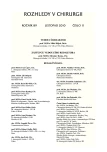Abdominal Catastrophe – Abdominal Wall Defect Associated with Gastrointestinal Fistula – Strategy of Therapy
Authors:
M. Chobola 1; L. Sobotka 2; A. Ferko 1; M. Oberreiter 3; M. Kaška 1; V. Motyčka 1; J. Páral 3; R. Mottl 2
Authors‘ workplace:
Chirurgická klinika Fakultní nemocnice Hradec Králové a Lékařské fakulty UK v Hradci Králové
přednosta kliniky: prof. MUDr. A. Ferko, CSc., vedoucí katedry chirurgie: doc. MUDr. RNDr. M. Kaška, Ph. D.
1; Klinika gerontologická a metabolická Fakultní nemocnice Hradec Králové a Lékařské fakulty UK
v Hradci Králové, přednosta kliniky: prof. MUDr. L. Sobotka, CSc.
2; Katedra válečné chirurgie, Fakulta vojenského zdravotnictví, Univerzita Obrany Brno
vedoucí katedry: doc. MUDr. L. Klein, CSc.
3
Published in:
Rozhl. Chir., 2010, roč. 89, č. 11, s. 672-678.
Category:
Monothematic special - Original
Overview
Background:
Wound dehiscence complicated by gastrointestinal (GI) fistula to belong „abdominal catastrophe”. Therapy is prolonged and connected with high morbidity and mortality rate.
Methods:
In the period from October 2006 to July 2009 we performed 12 reconstructive surgical procedures on gastrointestinal tract in patients with abdominal catastrophe. Treatment of 12 consecutive patients (9 men, 3 women) was managed according to a standardize protocol. The protocol consists of treatment of septic complications, optimisation of nutritional state, special wound procedures, diagnosis of gastrointestinal fistulas and GI tract, timing of surgical procedures, reconstruction of GI tract and postoperative care.
Results:
Reconstructive surgery of GI tract was successful on 11 patients. One patient developed recurrence of early GI fistula. In four patients we let open abdomen to heal per secundam. We observed no deaths after operation.
Conclusion:
With regard to complex character of therapy of abdominal catastrophe there is a need of multidisciplinary approach. Considering long-lasting and expensive therapy there is logical step to concentrate these patients into special centres which are experienced, equipped and their staff is trained in treatment of such a seriously impaired patients.
Key words:
wound dehiscence – gastrointestinal fistula – abdominal catastrophe – reconstructive surgery of gastrointestinal tract
Sources
1. Sobotka, L., Manak, J., Vyroubal, P., et al. Successful treatment of surgical abdominal wounds complicated by multiple bowel fistulas with a combination of total parenteral nutrition, hyaluronan-iodine complex and delayed surgery: results of a monocentric experience. Nutritional Therapy & Metabolism, 2008; 26 : 1–7.
2. Sriussadaporn, S., Sriussadaporn, S., Kritayakirana, K., et al. Operative management of small bowel fistulae associated with open abdomen. Asian. J. Surg., 2006; 29 : 1–7.
3. Visschers, R. G. J., Olde Damink, S. W. M., Winkens, B., et al. Treatment strategies in 135 consecutive patiens with enterocutaneous fistulas. World J. Surg., 2008; 32 : 445–453.
4. Sobotka, L., Maňak, J., Vyroubal, P., et al. Komplexní léčba abdominálních katastrof. Interní Med., 2008; 10 : 291–294.
5. Sitges-Serra, A., Jaurrieta, E., Stiges-Creus, A. Management of postoperative enterocutaneous fistulas: the roles of parenteral nutrition and surgery. Br. J. Surg., 1982; 69 : 147–150.
6. Mastboom, W. J., Kuypers, H. H., Schoots, F. J., et al. Small-bowel perforation complicating the open treatment of generalized peritonitis. Arch. Surg., 1989; 124 : 689–692.
7. Schein, M., Decker, G. A. Gastrointestinal fistulas associated with large abdominal wall defects: exprience with 43 patients. Br. J. Surg., 1990; 77 : 97–100.
8. Prickett, D., Montgomery, R., Cheadle, W. G. External fistulas arising from the digestive tract. South Med. J., 1991; 84 : 736–739.
9. Cro, C., George, K. J., Donnelly, J., et al. Vacuum assisted closure system in the management of enterocutaneous fistulae. Postgrad. Med. J., 2002; 78 : 364–365.
10. Demetriades, D. A technique of surgical closure of complex intestinal fistulae in the open abdomen. J. Trauma, 2003; 55 : 999–1001.
11. Ramirez, O. M., Ruas, E., Dellon, A. L. „Components separation” method for closure of abdominal-wall defects: an anatomic and clinical study. Plast. Reconstr. Surg., 1990; 86 : 519–526.
12. DiBello, J. K. Jr., More, J. H. Jr. Sliding myofascial flap of the rectus abdominus muscles for the closure of recurrent ventral hernias. Plast. Reconstr. Surg., 1996; 98 : 464–469.
Labels
Surgery Orthopaedics Trauma surgeryArticle was published in
Perspectives in Surgery

2010 Issue 11
Most read in this issue
- Mucinous Adenocarcinoma of the Appendix – Case Report
- Abdominal Catastrophe – Abdominal Wall Defect Associated with Gastrointestinal Fistula – Strategy of Therapy
- Five-Year Follow up in Patients after Surgery for Clear Cell Renal Carcinoma
- Torsion of the Omentum – An Uncommon Cause of Acute Abdomen
